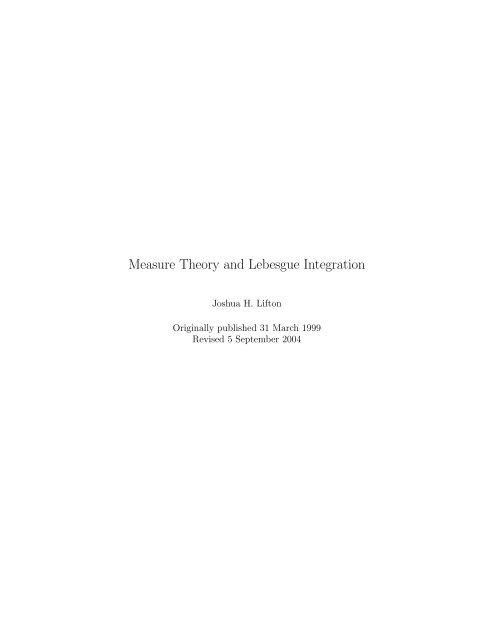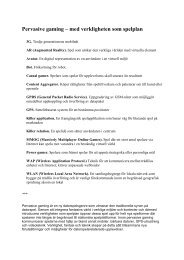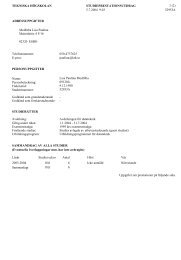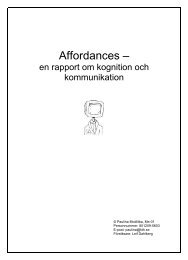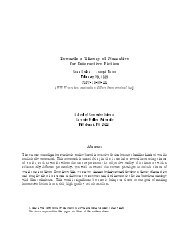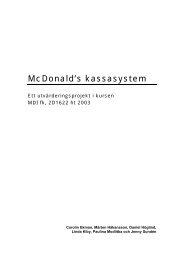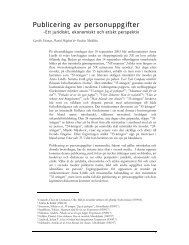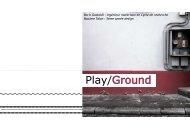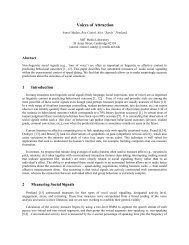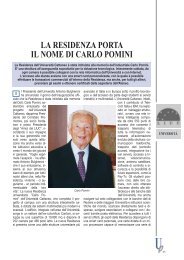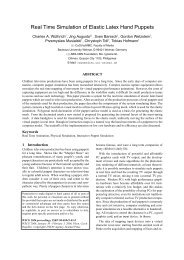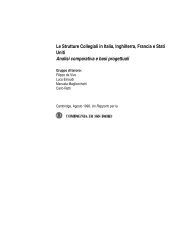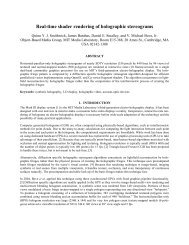Measure Theory and Lebesgue Integration - MIT Media Lab
Measure Theory and Lebesgue Integration - MIT Media Lab
Measure Theory and Lebesgue Integration - MIT Media Lab
Create successful ePaper yourself
Turn your PDF publications into a flip-book with our unique Google optimized e-Paper software.
<strong>Measure</strong> <strong>Theory</strong> <strong>and</strong> <strong>Lebesgue</strong> <strong>Integration</strong><br />
Joshua H. Lifton<br />
Originally published 31 March 1999<br />
Revised 5 September 2004
Abstract<br />
This paper originally came out of my 1999 Swarthmore College Mathematics<br />
Senior Conference. I’ve made minor touch-ups to make it more<br />
presentable.<br />
This paper begins where the Swarthmore College Mathematics <strong>and</strong> Statistics<br />
course Math 47: Introduction to Real Analysis left off. Namely, basic<br />
measure theory is covered with an eye toward exploring the <strong>Lebesgue</strong> integral<br />
<strong>and</strong> comparing it to the Riemann integral. Knowledge of the notation<br />
<strong>and</strong> techniques used in an introductory analysis course is assumed throughout.
Contents<br />
Acknowledgments ii<br />
1 How to Count Rectangles: A Review of <strong>Integration</strong> 1<br />
1.1 Riemann Revisited . . . . . . . . . . . . . . . . . . . . . . . . 1<br />
1.2 Shortcomings of Riemann <strong>Integration</strong> . . . . . . . . . . . . . 1<br />
1.3 A New Way to Count Rectangles: <strong>Lebesgue</strong> <strong>Integration</strong> . . . 2<br />
2 <strong>Measure</strong> <strong>Theory</strong> 4<br />
2.1 <strong>Measure</strong> . . . . . . . . . . . . . . . . . . . . . . . . . . . . . . 4<br />
2.2 Outer <strong>and</strong> Inner <strong>Measure</strong> . . . . . . . . . . . . . . . . . . . . 5<br />
2.3 Shortcomings of Outer <strong>and</strong> Inner <strong>Measure</strong> . . . . . . . . . . . 7<br />
3 Measurable Sets & Measurable Functions 8<br />
3.1 Measurable Sets . . . . . . . . . . . . . . . . . . . . . . . . . 8<br />
3.2 Measurable Functions . . . . . . . . . . . . . . . . . . . . . . 9<br />
3.3 Simple Functions . . . . . . . . . . . . . . . . . . . . . . . . . 12<br />
4 The <strong>Lebesgue</strong> Integral 13<br />
4.1 Integrating Bounded Measurable Functions . . . . . . . . . . 13<br />
4.2 Criteria for Integrability . . . . . . . . . . . . . . . . . . . . . 14<br />
4.3 Properties of the <strong>Lebesgue</strong> Integral . . . . . . . . . . . . . . . 16<br />
4.4 Integrating Unbounded Measurable Functions . . . . . . . . . 17<br />
5 Comparison of <strong>Lebesgue</strong> <strong>and</strong> Riemann Integrals 18<br />
5.1 Summary of Events . . . . . . . . . . . . . . . . . . . . . . . . 18<br />
5.2 Convergence of the <strong>Lebesgue</strong> Integral . . . . . . . . . . . . . . 18<br />
5.3 Convergence of the Riemann Integral . . . . . . . . . . . . . . 21<br />
5.4 A Final Comparison . . . . . . . . . . . . . . . . . . . . . . . 22<br />
References 24<br />
i
Acknowledgments<br />
Many thanks to all members of the Swarthmore College Mathematics <strong>and</strong><br />
Statistics Department for their encouragement <strong>and</strong> tolerance of my mathematics<br />
education.<br />
ii
Chapter 1<br />
How to Count Rectangles: A<br />
Review of <strong>Integration</strong><br />
1.1 Riemann Revisited<br />
The development of the integral in most introductory analysis courses is<br />
centered almost exclusively on the Riemann integral. This relatively intuitive<br />
approach begins by taking a partition P = {x0, . . . , xn} of the domain<br />
of the real-valued function f in question. Given P , the Riemann sum of f<br />
is simply<br />
n�<br />
(xi − xi−1) · f(ci) where xi−1 < ci < xi.<br />
i=1<br />
The integral of f, if it exists, is the limit of the Riemann sum as n → ∞.<br />
1.2 Shortcomings of Riemann <strong>Integration</strong><br />
Although the Riemann integral suffices in most daily situations, it fails to<br />
meet our needs in several important ways. First, the class of Riemann<br />
integrable functions is relatively small.<br />
Second <strong>and</strong> related to the first, the Riemann integral does not have<br />
satisfactory limit properties. That is, given a sequence of Riemann integrable<br />
functions {fn} with a limit function f = lim<br />
n→∞ fn, it does not necessarily<br />
follow that the limit function f is Riemann integrable.<br />
Third, all Lp spaces except for L∞ fail to be complete under the Riemann<br />
integral.<br />
Examples 1.1 <strong>and</strong> 1.2 illustrate some of these problems.<br />
1
Example 1.1 Consider the sequence of functions {fn} over the interval<br />
E = [0, 1].<br />
fn(x) =<br />
�<br />
2 n if 1<br />
2 n ≤ x ≤ 1<br />
2 n−1<br />
0 otherwise<br />
The limit function of this sequence is simply f = 0. In this example, each<br />
function in the sequence is integrable as is the limit function. However, the<br />
limit of the sequence of integrals is not equal to the integral of the limit of<br />
the sequence. That is,<br />
lim<br />
n→∞<br />
� 1<br />
0<br />
fn(x) dx = 1 �= 0 =<br />
� 1<br />
0<br />
lim<br />
n→∞ fn(x) dx.<br />
We will return to this function as an example of how the <strong>Lebesgue</strong> integral<br />
fails as well.<br />
Example 1.2 Consider the sequence of functions {dn} over the interval<br />
E = [0, 1].<br />
�<br />
dn(x) =<br />
1<br />
0<br />
if x ∈ {rn}<br />
otherwise<br />
where {rn} is the set of the first n elements of some decided upon enumeration<br />
of the rational numbers. Each function dn is Riemann integrable since<br />
it is discontinuous only at n points. The limit function D = lim<br />
n→∞ dn is given<br />
by<br />
D(x) =<br />
�<br />
1 if x is rational<br />
0 if x is irrational<br />
This function, known as the Dirichlet function, is discontinuous everywhere<br />
<strong>and</strong> therefore not Riemann integrable. Another way of showing that D(x) is<br />
not Riemann integrable is to take upper <strong>and</strong> lower sums, which result in 1<br />
<strong>and</strong> 0, respectively.<br />
1.3 A New Way to Count Rectangles: <strong>Lebesgue</strong><br />
<strong>Integration</strong><br />
An equally intuitive, but long in coming method of integration, was presented<br />
by <strong>Lebesgue</strong> in 1902. Rather than partitioning the domain of the<br />
function, as in the Riemann integral, <strong>Lebesgue</strong> chose to partition the range.<br />
Thus, for each interval in the partition, rather than asking for the value of
the function between the end points of the interval in the domain, he asked<br />
how much of the domain is mapped by the function to some value between<br />
two end points in the range. See Figure 1.1.<br />
range<br />
domain<br />
range<br />
domain<br />
Figure 1.1: Two ways to count rectangles – partitioning the range as opposed<br />
to partitioning the domain of a function.<br />
Partitioning the range of a function <strong>and</strong> counting the resultant rectangles<br />
becomes tricky since we must employ some way of determining (or measuring)<br />
how much of the domain is sent to a particular portion of a partition<br />
of the range. <strong>Measure</strong> theory addresses just this problem.<br />
As it turns out, the <strong>Lebesgue</strong> integral solves many of the problems left<br />
by the Riemann integral. With this in mind, we now turn to measure theory.
Chapter 2<br />
<strong>Measure</strong> <strong>Theory</strong><br />
<strong>Measure</strong> theory is a rich subject in <strong>and</strong> of itself. However, we present it here<br />
expressly for the purpose proposed at the end of §1.3; to define the “length”<br />
of an arbitrary set so as to formalize the idea of the <strong>Lebesgue</strong> integral. As<br />
such, only the very basics of measure theory are presented here <strong>and</strong> many<br />
of the rote proofs are left to the reader.<br />
2.1 <strong>Measure</strong><br />
Given an interval E = [a, b] <strong>and</strong> a set S of subsets of E which is closed under<br />
countable unions, we define the following.<br />
Definition 2.1 A set function on S is a function which assigns to each<br />
set A ∈ S a real number.<br />
Definition 2.2 A set function µ on S is called a measure if the following<br />
properties hold.<br />
• Semi-Positive-Definite: 0 ≤ µ(A) ≤ b − a for all A ∈ S.<br />
• Trivial Case: µ(∅) = 0.<br />
• Monotonicity: µ(A) ≤ µ(B) for all A, B ∈ S, A ⊂ B<br />
• Countable Additivity: if A = �∞ n=1 An, then µ(A) = �∞ n=1 µ(An),<br />
�<br />
where An ∈ S for n = 1, 2, . . . <strong>and</strong> An Am = ∅ for n �= m.<br />
As can be seen from the definition, the concept of measure is a general<br />
one indeed.<br />
4
Example 2.3 Examples of measure abound. To begin at the beginning, consider<br />
the trivial measure: µ(A) = 0 for all A ∈ S.<br />
Example 2.4 Let {x1, . . . , xn} ⊂ E be a finite set of points <strong>and</strong> E = [a, b].<br />
Let a < xi < xj < b for all i < j. Consider the set A = E/{x1, . . . , xn}, the<br />
interval E without the points x1, . . . , xn. Let our measure be such that the<br />
measure of any interval with endpoints x < y is y − x. Then,<br />
m(A) = m([a, x1) ∪ (x1, x2) ∪ . . . ∪ (xn−1, xn) ∪ (xn, b])<br />
= m([a, x1)) + m((x1, x2)) + . . . + m((xn−1, xn)) + m((xn, b])<br />
= (x1 − a) + (x2 − x1) + . . . + (xn − xn−1) + (b − xn)<br />
= b − a<br />
= m(E).<br />
Notice that the only complication which may arise in this example is how we<br />
define our set of subsets, S. We will explore this further in §2.3.<br />
2.2 Outer <strong>and</strong> Inner <strong>Measure</strong><br />
To keep us grounded in reality, we would like to use a measure which puts<br />
our intuitive notion of length at ease. Thus we define the following.<br />
Definition 2.5 The outer measure of any interval I on the real number<br />
line with endpoints a < b is b − a <strong>and</strong> is denoted as m ∗ (I).<br />
We would like to generalize this definition of outer measure to all sets of<br />
real numbers, not just intervals. To do this, we use the following theorem,<br />
upon which the remainder of our work depends heavily.<br />
Theorem 2.6 Every non-empty open set G ⊂ R can be uniquely expressed<br />
as a finite or countably infinite union of pairwise disjoint open intervals.<br />
Proof Idea: Let x ∈ G <strong>and</strong> consider the open interval Ix = (ax, bx) constructed<br />
from<br />
ax = glb{y | (y, x) ⊂ G}<br />
<strong>and</strong><br />
bx = lub{z | (x, z) ⊂ G}.<br />
Ix is called the component of x in G. G = ∪x∈GIx is exactly the decomposition<br />
of G we are looking for. It is straight-forward to show that, given
x1, x2 ∈ G, either Ix1 <strong>and</strong> Ix2 are disjoint or they are equal. The countability<br />
of this collection of open intervals follows easily from their disjointness;<br />
simply pick one rational number from each interval <strong>and</strong> use it to label that<br />
interval. Since the intervals are disjoint, no two will have the same label<br />
<strong>and</strong> since the rationals are countable, so will be the intervals which they label.<br />
Uniqueness of the decomposition is, as usual, a straight-forward proof<br />
by contradiction.<br />
With this theorem, it is possible to extend the definition of outer measure<br />
to open sets of real numbers.<br />
Definition 2.7 The outer measure m∗ (G) of an open set G ⊂ E is given<br />
by �<br />
i m∗ (Ii) where the Ii form the unique decomposition of G into a finite or<br />
a countably infinite union of pairwise disjoint open intervals. See Theorem<br />
2.6.<br />
From this directly follows a definition of outer measure for any set.<br />
Definition 2.8 The outer measure m ∗ (A) of any set A ⊂ R is given by<br />
glb{m ∗ (G)|A ⊂ G <strong>and</strong> G open in E}.<br />
Now that outer measure is well-defined for arbitrary subsets of E, we<br />
turn to a closely related measure, inner measure.<br />
Definition 2.9 The inner measure of any set A ⊂ E, denoted m∗(A),<br />
is defined as m ∗ (E) − m ∗ (E/A), where E/A is the compliment of A with<br />
respect to E.<br />
Intuitively, the inner measure is in some ways “measuring” the same thing<br />
as the outer measure, only in a more roundabout way. We cannot take it<br />
for granted, however, that the inner <strong>and</strong> outer measures of any given set are<br />
the same, although we are very interested in the cases when they are, as<br />
we shall soon see. For now, though, let us state without proof some simple<br />
observations regarding inner <strong>and</strong> outer measure.<br />
Lemma 2.10 The measures m∗ <strong>and</strong> m ∗ both exhibit monotonicity. That<br />
is, given A ⊂ B ⊂ E, it follows that,<br />
• m ∗ (A) ≤ m ∗ (B)<br />
• m∗(A) ≤ m∗(B)
Lemma 2.11 Given a set A ⊂ E, it follows that m∗(A) ≤ m ∗ (A).<br />
Lemma 2.12 The outer measure m ∗ exhibits subadditivity. That is, whenever<br />
{An | n = 1, 2, . . .} is a set of subsets of E, then<br />
m ∗ ∞�<br />
( An) ≤<br />
n=1<br />
∞�<br />
m ∗ (An).<br />
2.3 Shortcomings of Outer <strong>and</strong> Inner <strong>Measure</strong><br />
Now that we have some concrete measures to work with, we must examine<br />
whether they satisfy our needs. The first shortcoming we discover is<br />
presented below.<br />
Theorem 2.13 The outer measure, m ∗ , is not countably additive on the<br />
set of all subsets of E.<br />
Proof Idea: By construction. It is possible to construct pairwise disjoint<br />
sets An such that E = ∪ ∞ n=1 An <strong>and</strong> m ∗ (E) �= � ∞<br />
n=1 m∗ (An).<br />
This is rather disappointing. It would be nice to have a measure which<br />
is defined on all subsets of E <strong>and</strong> still satisfies our intuition enough to use it<br />
as the basis for the development of the <strong>Lebesgue</strong> integral. However, it turns<br />
out that the set of subsets of E on which the outer measure m ∗ is countably<br />
additive is large enough to make it worth our while to continue using the<br />
outer measure. We discuss this point in Chapter 3.<br />
n=1
Chapter 3<br />
Measurable Sets &<br />
Measurable Functions<br />
3.1 Measurable Sets<br />
Let’s look at a certain subset of all the sets on which inner <strong>and</strong> outer measure<br />
are well-defined – the set of <strong>Lebesgue</strong> measurable sets.<br />
Definition 3.1 A set A ⊂ E is <strong>Lebesgue</strong> measurable, or measurable,<br />
if m ∗ (A) = m∗(A), in which case the measure of A is denoted simply by<br />
m(A) <strong>and</strong> is given by m(A) = m ∗ (A) = m∗(A).<br />
A straight-forward extension of this definition applies to unbounded sets,<br />
Definition 3.2 The measure for an unbounded set A is defined simply as,<br />
m(A) = lim<br />
n→∞ m(A� [−n, n]).<br />
Lemma 3.3 Measurable sets have the following properties.<br />
• A set A ⊂ E is measurable if <strong>and</strong> only if<br />
m ∗ (A) + m ∗ (E/A) = b − a,<br />
where a <strong>and</strong> b are the endpoints of the interval E.<br />
• A set A ⊂ E is measurable if <strong>and</strong> only if its complement E/A is<br />
measurable.<br />
Proof: The lemma follows directly from the definition of measurable (3.1).<br />
8
Example 3.4 Referring back to Example 2.4, we see that a set consisting<br />
of an interval which is missing a finite number of points has the same outer<br />
measure as the interval itself. That is,<br />
m ∗ (E/{xi, . . . , xn}) = m ∗ (E).<br />
Thus, by Lemma 3.3, E/{xi, . . . , xn} is measurable if <strong>and</strong> only if<br />
m ∗ ({xi, . . . , xn}) = 0.<br />
The following theorem takes us back to where we left off at the end of<br />
§2.3.<br />
Theorem 3.5 The outer measure, m ∗ , is countably additive on the set of<br />
all measurable subsets of E. That is, whenever {An | n = 1, 2, . . .} is a set<br />
of measurable subsets of E, then<br />
m ∗ ∞�<br />
( An) =<br />
n=1<br />
∞�<br />
m ∗ (An)<br />
Proof Idea: Although the proof of this theorem is not difficult, it is somewhat<br />
lengthy in its technical detail <strong>and</strong> is therefore left for the enrichment<br />
of the reader.<br />
So, knowing that we intend to define the <strong>Lebesgue</strong> integral in terms of the<br />
outer measure, it seems that the size of the class of “<strong>Lebesgue</strong> integrable”<br />
functions may somehow be limited by the fact that, as far as we know, the<br />
outer measure is only defined on measurable sets. We will return to this<br />
idea in Chapter 4.<br />
3.2 Measurable Functions<br />
Definition 3.6 Let A be a bounded measurable subset of R <strong>and</strong> f : A → R<br />
a function. Then f is said to be measurable on A if {x ∈ A | f(x) > r}<br />
is measurable (as a set) for every real number r.<br />
There are many equivalent definitions of measurable which follow similar<br />
lines. In this definition we see the beginnings of being able to “count the<br />
rectangles” created by partitioning the range of a function rather than the<br />
domain. See Figure 3.1.<br />
n=1
ange<br />
r<br />
domain<br />
Figure 3.1: The function f is measurable if the shaded region of the domain<br />
is measurable as a set for all choices of the real number r.<br />
Example 3.7 Consider again the sequence of functions over E = [0, 1]<br />
defined in Example 1.1,<br />
fn(x) =<br />
�<br />
2 n if 1<br />
2 n ≤ x ≤ 1<br />
2 n−1<br />
0 otherwise<br />
We want to show that each fn is a measurable function. There are three<br />
cases to consider, corresponding to three possible choices for the real number<br />
r. They are,<br />
• r ≥ 2 n : The set {x ∈ E | fn(x) > r} is the null set <strong>and</strong> is therefore<br />
measurable.<br />
• 0 ≤ r < 2 n : The set {x ∈ E | fn(x) > r} is the closed interval<br />
[ 1<br />
2 n , 1<br />
2 n−1 ] <strong>and</strong> is therefore measurable (with a measure of 1<br />
2 n ).<br />
• r < 0 : The set {x ∈ E | fn(x) > r} is the entire interval E <strong>and</strong> is<br />
therefore measurable.<br />
Thus, each fn is a measurable function.
Example 3.8 Consider again the sequence of functions over E = [0, 1]<br />
defined in Example 1.2,<br />
�<br />
dn(x) =<br />
1<br />
0<br />
if x ∈ {rn}<br />
otherwise<br />
We want to show that each dn is a measurable function. There are three<br />
cases to consider, corresponding to three possible choices for the real number<br />
r. They are,<br />
• r ≥ 1 : The set {x ∈ E | dn(x) > r} is the null set <strong>and</strong> is therefore<br />
measurable.<br />
• 0 ≤ r < 1 : The set {x ∈ E | dn(x) > r} is the set of the first n rational<br />
numbers (in a decided upon enumeration) <strong>and</strong> is therefore measurable<br />
(with a measure of 0).<br />
• r < 0 : The set {x ∈ E | dn(x) > r} is the entire interval E <strong>and</strong> is<br />
therefore measurable.<br />
Thus, each dn is a measurable function.<br />
The above examples naturally bring up the question of whether or not<br />
the limit function of a sequence of measurable functions is itself a measurable<br />
function. Clearly, the limit function in Example 3.7 is measurable since it<br />
is the trivial function. But what of the Dirichlet function in Example 3.8?<br />
The following lemma answers this question.<br />
Lemma 3.9 If each function in a sequence {fn} is measurable on a set A<br />
<strong>and</strong> if f is the pointwise limit function of {fn}, then f is measurable on A<br />
as well.<br />
Proof: The proof of the lemma requires a close examination of the definitions<br />
of limit <strong>and</strong> measurable, as follows. Let x ∈ A <strong>and</strong> r ∈ R such that<br />
f(x) > r. Let p be a natural number such that f(x) > r + 1/p. Then, by<br />
definition of limit, there exists a natural number N such that for all n > N,<br />
fn(x) > r + 1/p. Thus,<br />
This implies that<br />
{x ∈ A | f(x) > r} =<br />
f(x) = lim<br />
n→∞ fn(x) > r + 1/p > r.<br />
∞�<br />
∞�<br />
∞�<br />
p=1 N=1 n=N+1<br />
{x ∈ A | fn(x) > r + 1/p}.<br />
Since this set is measurable <strong>and</strong> r was arbitrary, it follows that f is measurable.
3.3 Simple Functions<br />
Similar to the way which step functions are put to use in the development the<br />
Riemann integral, our development of the <strong>Lebesgue</strong> integral will make use<br />
of a pedestrian class of measurable functions, aptly named simple functions.<br />
Definition 3.10 A simple function f : A → R is a measurable function<br />
which takes on finitely many values.<br />
We’ve already seen simple functions in Examples 1.1 <strong>and</strong> 1.2. The utility of<br />
simple functions becomes apparent in the following theorem.<br />
Theorem 3.11 A function f : A → R is measurable if <strong>and</strong> only if it is the<br />
pointwise limit of a sequence of simple functions.<br />
Proof Idea: (⇒) The forward direction of the proof involves constructing<br />
a sequence of simple functions whose limit is the given measurable function<br />
f. This construction is omitted for brevity.<br />
(⇐) The reverse direction is given by Lemma 3.9.<br />
Example 3.12 Example 3.8 combined with Theorem 3.11 (or even just<br />
Lemma 3.9) tells us that the Dirichlet function is indeed measurable.
Chapter 4<br />
The <strong>Lebesgue</strong> Integral<br />
4.1 Integrating Bounded Measurable Functions<br />
We introduce the <strong>Lebesgue</strong> integral by first restricting our attention to<br />
bounded measurable functions. The approach here is almost identical to<br />
that used in constructing the Riemann integral except that here we partition<br />
the range rather than the domain of the function.<br />
Let f : A → R be a bounded measurable function on a bounded measurable<br />
subset A of R. Let l = glb{f(x) | x ∈ A} <strong>and</strong> u > lub{f(x) | x ∈ A}<br />
where u is arbitrary insofar as it is greater than the least upper bound of f<br />
on A.<br />
As with the Riemann integral, we’ll define the <strong>Lebesgue</strong> integral of f<br />
over an interval A as the limit of some “<strong>Lebesgue</strong> sum”.<br />
Definition 4.1 The <strong>Lebesgue</strong> sum of f with respect to a partition P =<br />
{y0, . . . , yn} of the interval [l, u] is given as<br />
L(f, P ) =<br />
n�<br />
i=1<br />
y ∗ i m({x ∈ A | yi−1 ≤ f(x) < yi})<br />
where y ∗ i ∈ [yi−1, yi] for i = 1, . . . , n <strong>and</strong> f is a bounded measurable function<br />
over a bounded measurable set A ⊂ R.<br />
This is the new way to count rectangles; the y∗ i is the height of the rectangle<br />
<strong>and</strong> the m({x ∈ A | yi−1 ≤ f(x) < yi}) serves as the base of the rectangle.<br />
The definition of the actual <strong>Lebesgue</strong> integral is virtually identical to that<br />
of the Riemann integral.<br />
13
Definition 4.2 A bounded measurable function f : A → R is <strong>Lebesgue</strong><br />
integrable on A if there is a number L ∈ R such that, given ɛ > 0, there<br />
exists a δ > 0 such that |L(f, P ) − L| < ɛ whenever ||P || < δ. L is known<br />
as the <strong>Lebesgue</strong> integral of f on A <strong>and</strong> is denoted by �<br />
f dm.<br />
4.2 Criteria for Integrability<br />
As with the definition of the Riemann integral, the definition of the <strong>Lebesgue</strong><br />
integral does not illuminate us as to whether a given function is <strong>Lebesgue</strong><br />
integrable <strong>and</strong>, if it is, what the <strong>Lebesgue</strong> integral is. The following theorem,<br />
presented without proof, fills this gap.<br />
Theorem 4.3 A bounded measurable function f is <strong>Lebesgue</strong> integrable on<br />
a bounded measurable set A if <strong>and</strong> only if, given ɛ > 0, there exist simple<br />
functions f <strong>and</strong> f such that<br />
f ≤ f ≤ f<br />
<strong>and</strong> � �<br />
f dm −<br />
A<br />
A<br />
f dm < ɛ.<br />
Corollary 4.4 If f is a bounded measurable function on a bounded measurable<br />
set A, then f is <strong>Lebesgue</strong> integrable on A. Furthermore,<br />
�<br />
��<br />
�<br />
f dm =lub f dm | f is simple <strong>and</strong> f ≤ f<br />
A<br />
A<br />
��<br />
�<br />
=glb f dm | f is simple <strong>and</strong> f ≥ f .<br />
A<br />
Proof Idea: This corollary is a result of the proof of Theorem 4.3.<br />
Example 4.5 Let’s find the <strong>Lebesgue</strong> integral of the Dirichlet function (see<br />
Example 1.2). We know by Example 3.12 that the Dirichlet function is<br />
measurable. Thus, by Corollary 4.4, it is <strong>Lebesgue</strong> integrable. Specifically,<br />
we claim that �<br />
[0,1] D dm = 0. Looking back to the definition of the <strong>Lebesgue</strong><br />
integral (4.2), we must show that, given ɛ > 0, there exists a δ > 0 such that<br />
|L(D, P )| < ɛ whenever the width of the partition P is less than δ. Referring<br />
to Definition 4.1 for |L(D, P )|, this means that we must find δ such that<br />
|L(D, P )| =<br />
n�<br />
i=1<br />
y ∗ i m({x ∈ [0, 1] | yi−1 ≤ D(x) < yi}) < ɛ,<br />
A
where P = {y0 = 0, . . . , yn = 2} is a partition of the interval [0, 2] in the<br />
range, y ∗ i ∈ [yi−1, yi] for i = 1, . . . , n, <strong>and</strong> the absolute value signs have been<br />
omitted since all quantities here are inherently positive. We accomplish this<br />
by picking δ = ɛ/3. Then<br />
|L(D, P )| =<br />
n�<br />
y ∗ i m({x ∈ [0, 1] | yi−1 ≤ D(x) < yi})<br />
i=1<br />
=y ∗ 1 m({x ∈ [0, 1] | 0 ≤ D(x) < ɛ/3})<br />
+ y ∗ j m({x ∈ [0, 1] | yj−1 ≤ D(x) < yj}),<br />
where yj−1 ≤ 1 < yj. All other terms in the sum vanish because D(x) only<br />
takes on two values, 0 <strong>and</strong> 1. The first term achieves its maximum when<br />
y∗ 1 = ɛ/3 <strong>and</strong> when m({x ∈ [0, 1] | 0 ≤ D(x) < ɛ/3} = 1. Thus,<br />
|L(D, P )| =<br />
n�<br />
Also, we know that y ∗ j<br />
y ∗ i m({x ∈ [0, 1] | yi−1 ≤ D(x) < yi})<br />
i=1<br />
≤[ɛ/3] + [y ∗ j m({x ∈ [0, 1] | yj−1 ≤ D(x) < yj})].<br />
< 1 + ɛ/3. Finding an upper bound on<br />
m({x ∈ [0, 1] | yj−1 ≤ D(x) < yj})<br />
is equivalent to asking for an upper bound on the measure of the rational<br />
numbers in the interval [0, 1]. Since any non-empty open interval centered<br />
on a rational number contains other rational numbers, an upper bound on<br />
the measure of the rational numbers is simply the sum of the measures of<br />
all the intervals surrounding the rationals. That is, given an enumeration<br />
of the rationals, let the n th rational number be contained in an interval of<br />
measure ɛ/3 n+1 . In this way,<br />
<strong>and</strong> we finally get that<br />
m({x ∈ [0, 1] | yj−1 ≤ D(x) < yj}) <<br />
∞� ɛ ɛ<br />
=<br />
3n+1 6 ,<br />
n=1<br />
|L(D, P )| ≤ɛ/3 + y ∗ j m({x ∈ [0, 1] | yj−1 ≤ D(x) < yj})<br />
where we have assumed without loss of generality that ɛ < 1. This completes<br />
the proof that �<br />
[0,1] D dm = 0. Combined with Lemma 3.3, we also know<br />
that the irrationals must have measure 1 on the interval [0, 1]. This result<br />
makes intuitive sense since the rationals are countably infinite whereas the<br />
irrationals are uncountably infinite.<br />
4.3 Properties of the <strong>Lebesgue</strong> Integral<br />
It is comforting to know that the <strong>Lebesgue</strong> integral shares many properties<br />
with the Riemann integral.<br />
Theorem 4.6 Let f <strong>and</strong> g be bounded measurable functions on a bounded<br />
measurable set A. Then,<br />
• Monotonicity: If f ≤ g, then � �<br />
A f dm ≤ A g dm.<br />
• Linearity: �<br />
� �<br />
(f + g) dm = f dm + g dm<br />
A<br />
A<br />
A<br />
<strong>and</strong> �<br />
�<br />
cf dm = c f dm for c ∈ R.<br />
A<br />
A<br />
• For any numbers l, u ∈ R such that l ≤ f ≤ u, it follows that<br />
l · m(A) ≤ �<br />
A f dm ≤ u · m(A).<br />
• | � �<br />
A f dm| ≤ A |f| dm.<br />
• If A <strong>and</strong> B are disjoint bounded measurable sets <strong>and</strong> f : A ∪ B → R<br />
is a bounded measurable function, then<br />
�<br />
� �<br />
f dm = f dm + f dm.<br />
A∪B<br />
A<br />
• Countable Additivity: If A = ∪ ∞ i=1 Ai where the Ai are pairwise disjoint<br />
bounded measurable sets, then<br />
�<br />
A<br />
f dm =<br />
∞�<br />
�<br />
i=1<br />
Ai<br />
B<br />
f dm.<br />
Further comparison of the Riemann <strong>and</strong> the <strong>Lebesgue</strong> integral is made<br />
in Chapter 5.
4.4 Integrating Unbounded Measurable Functions<br />
Thus far, we have restricted ourselves to integrating bounded measurable<br />
functions. The generalization of the <strong>Lebesgue</strong> integral to unbounded measurable<br />
functions is straight-forward but will not be given in full detail here.<br />
In general, though, it involves the introduction of ±∞ as possible values of<br />
the integral. As it turns out, all of the properties of the <strong>Lebesgue</strong> integral<br />
listed in §4.3 hold for unbounded measurable functions as well.
Chapter 5<br />
Comparison of <strong>Lebesgue</strong> <strong>and</strong><br />
Riemann Integrals<br />
5.1 Summary of Events<br />
Having achieved what we first set out to do – to define an integral based on<br />
a new way of counting rectangles, let us look back at the motivation behind<br />
this endeavor. As outlined in §1.2, we are striving to define an integral such<br />
that the class of integrable functions is large <strong>and</strong> well-behaved. Ideally, we<br />
would like the class of integrable functions to have nice limit properties; that<br />
the integral of the limit is the limit of the integral. Examples 1.1 <strong>and</strong> 1.2<br />
show that this is not in general true of the Riemann integral.<br />
Aside from examining the convergence properties of the <strong>Lebesgue</strong> integral,<br />
we are also interested in how it behaves relative to the Riemann<br />
integral. Is a Riemann integrable function <strong>Lebesgue</strong> integrable <strong>and</strong>, if so,<br />
what are the values of the respective integrals?<br />
5.2 Convergence of the <strong>Lebesgue</strong> Integral<br />
The following lemmas <strong>and</strong> theorems build upon each other <strong>and</strong> end with<br />
a broad statement which identifies when the limit <strong>and</strong> <strong>Lebesgue</strong> integral<br />
operations are interchangeable.<br />
Lemma 5.1 Let g be a non-negative measurable function on a bounded measurable<br />
set A. If {An} are measurable subsets of A such that<br />
A1 ⊂ A2 ⊂ A3 ⊂ · · · ,<br />
18
<strong>and</strong> if L ∈ R is such that L ≥ �<br />
�<br />
g dm for all n, then L ≥ g dm.<br />
An ∪An<br />
Proof Idea: (Proof by belief). Given that the <strong>Lebesgue</strong> integral depends<br />
on the measure of subsets of the domain of the function, <strong>and</strong> that measure<br />
follows our intuition, this lemma is easy to believe without proof.<br />
Theorem 5.2 (Monotone Convergence Theorem) Let A be a bounded measurable<br />
subset of R <strong>and</strong> {fn} be a sequence of measurable functions on A<br />
such that 0 ≤ f1 ≤ f2 ≤ · · · . Let f be the pointwise limit of {fn}. That is,<br />
lim<br />
n→∞ fn(x) = f(x)<br />
for all x ∈ E. Then f is integrable <strong>and</strong><br />
� �<br />
lim<br />
n→∞<br />
fn dm =<br />
A<br />
A<br />
f dm.<br />
Proof: By Lemma 3.9, f is measurable since each fn is measurable. Monotonicity<br />
of the <strong>Lebesgue</strong> integral (Theorem 4.6) implies that ��<br />
A fn dm � is<br />
an increasing sequence. So, not discounting ∞ as a possibility, this sequence<br />
has a limit L. Since f ≥ fn implies that � �<br />
A f dm ≥ A fn dm for all n, it<br />
follows that �<br />
A f dm ≥ L.<br />
On the other h<strong>and</strong>, we can also show that �<br />
A f dm ≤ L. Let c ∈ (0, 1)<br />
<strong>and</strong> let g : A → R be a simple function such that 0 ≤ g ≤ f. Consider<br />
the sets An = {x | fn(x) ≥ cg(x)}, which happen to satisfy the hypotheses of<br />
Lemma<br />
�<br />
5.1. The reason for including c is so that cg < f, which implies that<br />
∞<br />
n=1 An = A. For any n = 1, 2, · · · , we have<br />
� �<br />
�<br />
L = lim fn dm ≥ fn dm ≥ c g dm.<br />
n→∞<br />
A<br />
An<br />
An<br />
By Lemma 5.1, L ≥ c �<br />
∪An g dm. Since �∞ n=1 An = A <strong>and</strong> c ∈ (0, 1) was<br />
arbitrary, it follows that L ≥ �<br />
g dm. By Corollary 4.4,<br />
∪An<br />
�<br />
��<br />
�<br />
f dm = lub f dm | f is simple <strong>and</strong> f ≤ f ,<br />
A<br />
A<br />
we get L ≥ �<br />
A f dm.<br />
Combining the above two inequalities gives L = �<br />
f dm, as desired.<br />
Lemma 5.3 (Fatou’s Lemma) Let A ⊂ R be a bounded measurable set. If<br />
{fn} is a sequence of non-negative measurable functions on A <strong>and</strong><br />
f(x) = lim fn(x) ≡ lim<br />
n→∞<br />
n→∞ {glb fk(x) | k ≥ n}<br />
A
for every x ∈ A, then �<br />
Proof: Let<br />
A<br />
�<br />
f dm ≤ lim A<br />
n→∞<br />
fn dm.<br />
gn(x) = glb{fk(x) | k ≥ n}<br />
for each n = 1, 2, · · · <strong>and</strong> for each x ∈ A. Each gn is a measurable function<br />
since the set<br />
∞�<br />
{x | gn(x) > r} = {x | fk(x) > r}<br />
is measurable. Notice that gn ≤ fn for all n <strong>and</strong> that {gn} is a monotonically<br />
increasing sequence of non-negative functions.<br />
By definition,<br />
k=n<br />
lim<br />
n→∞ gn(x) = lim<br />
n→∞ {glb fk(x) | k ≥ n} ≡ lim fn(x) = f(x).<br />
n→∞<br />
Therefore, by the Monotone Convergence Theorem (5.2),<br />
� �<br />
lim<br />
n→∞<br />
gn dm =<br />
A<br />
f dm.<br />
A<br />
This, combined with<br />
�<br />
�<br />
gn(x) dm ≤<br />
A<br />
A<br />
fn(x) dm for each n <strong>and</strong> each x ∈ A<br />
due to the monotonicity (Theorem 4.6) of the <strong>Lebesgue</strong> integral, leads to<br />
� �<br />
�<br />
lim<br />
n→∞<br />
gn dm =<br />
A<br />
f dm ≤ lim<br />
A<br />
n→∞<br />
fn dm,<br />
A<br />
as desired.<br />
Theorem 5.4 (<strong>Lebesgue</strong> Dominated Convergence Theorem) Let A ∈ R be<br />
a bounded measurable set <strong>and</strong> let {fn} be a sequence of measurable functions<br />
on A such that lim<br />
n→∞ fn(x) = f(x) for all x ∈ A. If there exists a function<br />
g whose <strong>Lebesgue</strong> integral is finite such that |fn(x)| ≤ g(x) for all n <strong>and</strong> all<br />
x ∈ A, then<br />
� �<br />
lim<br />
n→∞<br />
fn dm =<br />
A<br />
f dm.<br />
A<br />
Proof: To begin, the functions fn <strong>and</strong> f have finite <strong>Lebesgue</strong> integrals since<br />
g does (this fact does take some proof, but is omitted here). By our choice<br />
of g we have fn + g ≥ 0 on the set A. So,<br />
�<br />
�<br />
(f + g) dm ≤ lim<br />
A<br />
n→∞<br />
(fn + g) dm<br />
A
y Fatou’s Lemma (5.3) <strong>and</strong> hence,<br />
�<br />
�<br />
f dm ≤ lim<br />
n→∞<br />
A<br />
A<br />
fn dm<br />
A<br />
by the linearity of the <strong>Lebesgue</strong> integral (Theorem 4.6).<br />
The same argument can be used with the function g − fn to obtain<br />
�<br />
� � �<br />
− f dm ≤ lim<br />
n→∞<br />
− .<br />
fn dm<br />
A<br />
But since<br />
� � � � � �<br />
lim<br />
n→∞<br />
− fn dm<br />
A<br />
= lim glb −<br />
n→∞<br />
� �<br />
= lim lub<br />
n→∞<br />
�<br />
≡ lim<br />
n→∞<br />
it follows that �<br />
f dm ≥ lim<br />
A<br />
n→∞<br />
fn dm,<br />
A<br />
�<br />
fk dm<br />
A<br />
�<br />
fk dm | k ≥ n<br />
A<br />
fn dm.<br />
A<br />
Finally, combining the above two inequalities,<br />
�<br />
�<br />
�<br />
f dm ≤ lim fn dm ≤ lim<br />
A<br />
n→∞ A<br />
n→∞<br />
�<br />
A fn dm exists <strong>and</strong> is equal to �<br />
shows that lim<br />
n→∞<br />
fn dm ≤<br />
A<br />
A<br />
�<br />
�<br />
| k ≥ n<br />
�<br />
A<br />
f dm,<br />
f dm, as desired.<br />
5.3 Convergence of the Riemann Integral<br />
Now that we have a grasp of the convergence properties of the <strong>Lebesgue</strong><br />
integral, let’s compare it with those of the Riemann integral. The Riemann<br />
equivalent to the <strong>Lebesgue</strong> Dominated Convergence Theorem (5.4), is stated<br />
below in Theorem 5.5.<br />
Theorem 5.5 Let a, b ∈ R, a < b, <strong>and</strong> let {fn} be a uniformly convergent<br />
sequence of Riemann integrable functions on [a, b] such that<br />
lim<br />
n→∞ fn(x) = f(x) for all x ∈ [a, b]. Then<br />
lim<br />
n→∞<br />
� b<br />
a<br />
fn(x) dx =<br />
� b<br />
a<br />
f(x) dx.
Recall that {fn} is uniformly convergent if, given ɛ > 0, there exists a<br />
natural number N such that |f(x) − fn(x)| < ɛ whenever n > N, for all<br />
x ∈ [a, b]. Clearly, the hypotheses placed on {fn} in order for the <strong>Lebesgue</strong><br />
Dominated Convergence Theorem to hold are much less stringent than requiring<br />
{fn} to converge uniformly. Thus, we can at least expect that the<br />
class of <strong>Lebesgue</strong> integrable functions has somewhat better limit properties<br />
than those of the class of Riemann integrable functions. In fact, we have<br />
already witnessed this in Example 4.5 with the Dirichlet function.<br />
5.4 A Final Comparison<br />
The following theorem, stated without proof, explicitly relates the Riemann<br />
<strong>and</strong> <strong>Lebesgue</strong> integrals.<br />
Theorem 5.6 If f is Riemann integrable on [a,b], then f is <strong>Lebesgue</strong> integrable<br />
on [a,b], <strong>and</strong><br />
� b �<br />
f(x) dx = f dm.<br />
a<br />
What’s more, we’ve already seen that the converse of this theorem isn’t true.<br />
Thus, not only does the class of <strong>Lebesgue</strong> integrable functions have better<br />
limit properties, but it is also larger than the class of Riemann integrable<br />
functions.<br />
As promised in §1.2, we now turn to the <strong>Lebesgue</strong> integral to re-examine<br />
the function given in Example 1.1.<br />
Example 5.7 Consider the sequence of functions {fn} over the interval<br />
E = [0, 1].<br />
fn(x) =<br />
[a,b]<br />
�<br />
2 n if 1<br />
2 n ≤ x ≤ 1<br />
2 n−1<br />
0 otherwise<br />
The limit function of this sequence is simply f = 0. In this example, each<br />
function in the sequence is Riemann integrable, as is the limit function.<br />
However, the limit of the sequence of Riemann integrals is not equal to the<br />
Riemann integral of the limit of the sequence. That is,<br />
lim<br />
n→∞<br />
� 1<br />
0<br />
fn(x) dx = 1 �= 0 =<br />
By Theorem 5.6, it is also the case that<br />
�<br />
�<br />
lim<br />
n→∞<br />
fn dm = 1 �= 0 =<br />
[0,1]<br />
� 1<br />
0<br />
[0,1]<br />
lim<br />
n→∞ fn(x) dx.<br />
lim<br />
n→∞ fn(x) dx.
This example goes to show that, although the <strong>Lebesgue</strong> integral is superior<br />
to the Riemann integral insofar as the size of the class of integrable<br />
functions <strong>and</strong> the limit properties of these functions, there are still functions<br />
which defy <strong>Lebesgue</strong> integration.<br />
One point we have not yet touched on is the effect of the <strong>Lebesgue</strong> integral<br />
on the Lp spaces. It turns out that L2 is complete under the <strong>Lebesgue</strong><br />
integral. This is of considerable importance, especially when dealing with<br />
the theory behind Fourier series. However interesting that topic may be,<br />
though, it will have to wait for another time.
References<br />
[1] HJ Wilcox, DL Myers, An Introduction to <strong>Lebesgue</strong> <strong>Integration</strong><br />
<strong>and</strong> Fourier Series, Dover Publications, Inc., New York, 1978.<br />
[2] M Rosenlicht, Introduction to Analysis, Dover Publications, Inc.,<br />
New York, 1968.<br />
24


